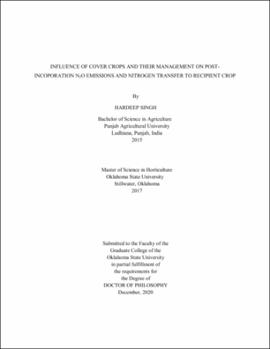| dc.contributor.advisor | Kakani, Gopal | |
| dc.contributor.author | Singh, Hardeep | |
| dc.date.accessioned | 2021-05-25T20:32:19Z | |
| dc.date.available | 2021-05-25T20:32:19Z | |
| dc.date.issued | 2020-12 | |
| dc.identifier.uri | https://hdl.handle.net/11244/329938 | |
| dc.description.abstract | Including cover crops in production systems for improving soil health and nutrient cycling has gained interest in recent years. Although cover crops may provide many agronomic and environmental benefits, they may also increase nitrous oxide (N2O) emissions, a potent greenhouse gas, during residue decomposition. Increased N2O emissions from decomposing cover crop residues may offset potential benefits associated with increased carbon uptake due to greater radiative forcing of N2O. Emissions from decomposing cover crops depend on various factors such as type of cover crop, management of cover crop residue, physiochemical properties of cover crops, soil temperature, and soil moisture. Therefore, different field and greenhouse studies were conducted to evaluate the impacts of types of cover crops (leguminous (grass pea and hairy vetch) and non-leguminous (oat)), different forms of management of cover crop residues (removal and retention of aboveground biomass), incorporation at different maturity levels (vegetative or reproductive stages), and different moisture levels (rainfall immediately after cover crop incorporation and rainfall a week after cover crop incorporation) at time of soil incorporation of cover crops on N2O emissions. A treatment with no cover crop was included as the control in each experiment. Results showed that effect of maturity level at termination on cumulative N2O emissions was significant (P < 0.05) with 30-35% greater emissions recorded from both leguminous and non-leguminous cover crops terminated at the reproductive stage than the vegetative stage. It was also observed that greater biomass yields by a non-leguminous cover crop (oat) could lead to greater N2O emissions after soil incorporation as compared to incorporation of a less-productive leguminous (grass pea) cover crop. Additionally, the removal of aboveground biomass of leguminous cover crop (grass pea) was an effective management strategy to mitigate N2O emissions. Soil incorporation of legumes based on a short-term rainfall forecast may not be an effective tool to avoid large N2O emissions as emissions were not significantly different between early and late simulated rainfall treatments. Therefore, it can be concluded that post-incorporation N2O emissions from cover crop residue can be mitigated by incorporating at proper stages of maturity and removing aboveground biomass of the cover crop for forage. Future research should consider interaction of cover crop incorporation with various environment variables such as timing and frequency of rainfall events, soil temperature, and abundance of denitrifying communities. | |
| dc.format | application/pdf | |
| dc.language | en_US | |
| dc.rights | Copyright is held by the author who has granted the Oklahoma State University Library the non-exclusive right to share this material in its institutional repository. Contact Digital Library Services at lib-dls@okstate.edu or 405-744-9161 for the permission policy on the use, reproduction or distribution of this material. | |
| dc.title | Influence of cover crops and their management on post-incorporation N2O emissions and nitrogen transfer to recipient crop | |
| dc.contributor.committeeMember | Northup, Brian | |
| dc.contributor.committeeMember | Deng, Shiping | |
| dc.contributor.committeeMember | Dunn, Bruce | |
| osu.filename | Singh_okstate_0664D_16988.pdf | |
| osu.accesstype | Open Access | |
| dc.type.genre | Dissertation | |
| dc.type.material | Text | |
| dc.subject.keywords | cover crops | |
| dc.subject.keywords | n2o emissions | |
| dc.subject.keywords | nitrogen mineralization | |
| dc.subject.keywords | rainfall | |
| thesis.degree.discipline | Crop Science | |
| thesis.degree.grantor | Oklahoma State University | |
